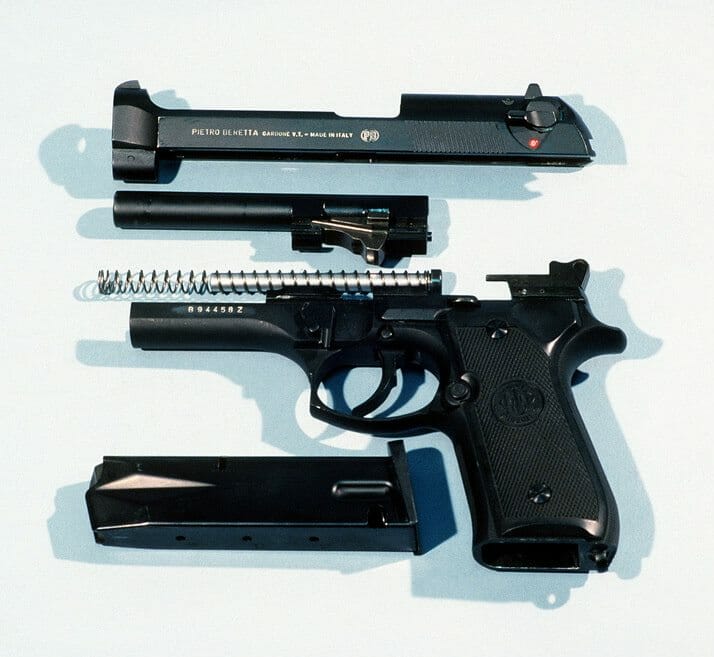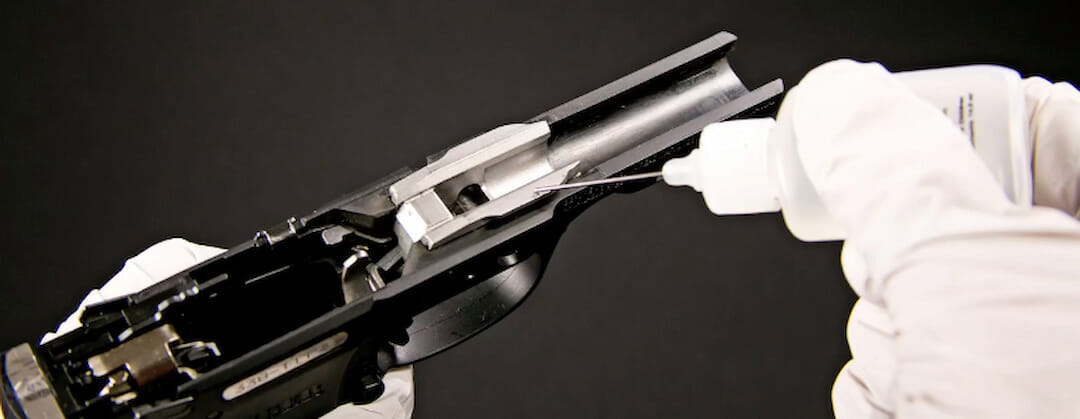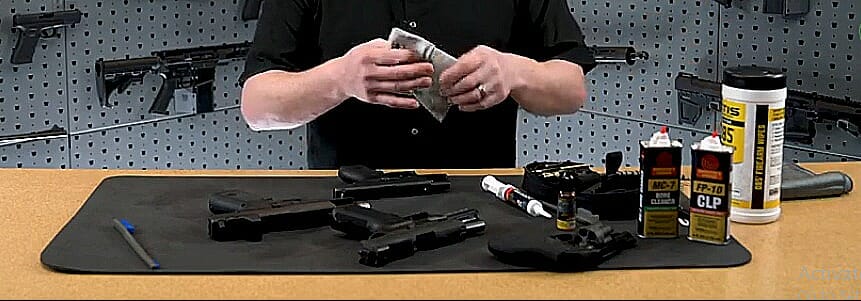If you properly clean and maintain a pistol it can last for generations. As a gun owner, I understand the importance of keeping my firearm in top condition to ensure its reliability and functionality and my job is to make sure you understand it too. In my guides I try to cover as much as I can about guns, and in this article I'll guide you through the easy steps of how to clean a pistol effectively.
By following these instructions, not only will you extend the lifespan of your gun, but you'll also ensure that it performs at its best whenever you use it. We'll cover everything from gathering the necessary tools/supplies to safely disassembling and cleaning each part of your handgun.
Whether you're a seasoned shooter or a new gun owner, I’m sure you’ll be able to learn a thing or two on this very important topic.
Key Takeaways:
- Necessary tools for cleaning a pistol: gun cleaning kits, cleaning rods, brushes, patches, nylon brush, and cotton t-shirt rags.
- The process of cleaning a pistol involves unloading the gun, field stripping it, and doing basic cleaning and lubrication.
Tools You Need To Clean A Pistol
When cleaning a pistol, you want to have the right tools on hand to ensure that you can properly clean every single part of your pistol. Some essential tools are carbon fouling removal tool, bore snake, bore brush, and cotton swabs.

A carbon fouling removal tool helps by removing stubborn carbon buildup in the barrel and other hard-to-reach areas that you can’t with your hands.
A bore snake is another great tool that helps you quickly clean the barrel by pulling it through with a brush. Bore brushes come in different sizes and materials such as bronze or nylon, allowing you to effectively remove debris from the barrel depending how difficult it is for you.
Additionally, cotton swabs are handy for applying solvents or oils to small parts of the pistol that require extra attention and help you scrub your gun down.
By having these tools readily available in a multi-tool kit, you can save time searching for individual items and focus on giving your pistol a thorough cleaning.
How To Clean a Pistol in 4 Simple Steps
Cleaning a pistol doesn’t have to be intimidating. In fact, it isn’t hard - there are only a few key points to keep in mind.
Unload The Firearm
There is a reason this step is first - you want to avoid accidental discharge. Here are a few steps to follow.
1. Take out the magazine - easy enough
2. Inspect the chamber - inspect the chamber to ensure there are no rounds still in the chamber. Then use a dry patch on a cleaning rod to double-check that the barrel is clear. It's important to always wear safety glasses during this process in case of accidental discharge or debris. Now you can move forward to disassembling your firearm knowing that there is no risk of accidental firing.
Disassemble Your Firearm
To properly clean your pistol, you'll need to break it down into its major components. Here are the steps to disassemble your firearm for cleaning:
- Gather your cleaning kit: Make sure you have all the necessary tools and supplies including brushes, patches, solvent, and lubricant.
- Identify the type of pistol: Whether you want to clean a revolver or a semiautomatic pistol, it’s helpful to know if there are specific disassembly instructions. Refer to the owner's manual if needed.
- Disassemble according to instructions: Follow the manufacturer's guidelines or manual on how to field strip your particular pistol model. This will involve removing certain parts such as the slide or cylinder.
Now that we've successfully disassembled our firearm for cleaning, let's move on to cleaning it.

3. Cleaning Your Pistol
When it comes to cleaning a pistol, there are several key areas that need attention - the barrel, slide and recoil spring, and pistol frame. We’ll go into more detail on how to clean each below
Cleaning The Barrel
To effectively clean the barrel, use a bore cleaner and a nylon brush. This combination will help you remove stubborn powder fouling that may have accumulated around the feed ramp.
Start by applying the bore cleaner to a patch and pushing it through the barrel from the breech to the muzzle. You may need to repeat this process with multiple patches until you see there is no more solvent residue.
Then, take a wet bore brush and scrub back and forth through the barrel about 5-10 times until it comes out smooth and stops racking up debris.
Afterward, wipe down the outside of the barrel with a rag.
Finally, run one gun-oil-soaked patchthe bore to protect it from corrosion. Then follow that with running a dry patch through so you avoidleaving excess oil behind.
Now that we've thoroughly cleaned the barrel, let's move on to cleaning the pistol slide and recoil spring.

Cleaning the Slide and Recoil Spring
Having given the barrel a thorough cleaning, let's turn our attention to cleaning up the slide and recoil spring. Cleaning both is essential for maintaining smooth firing operation and reliability. Here are four steps to get it looking lean, clean, and pristine:
1. Wipe down the inside and bottom of the slide with a clean patch/rag to remove any old oil, powder fouling, or any other debris.
2. Add solvent to dirty areas inside the slide using a clean patch or Q-tip. Be careful not to get any solvent on your red dot optic if your pistol has one as solvent can ruin it.
3. Use a nylon brush if necessary to scrub away stubborn deposits & debris. Pay special attention to the slide rails where most of the friction occurs.
4. Wipe everything clean with a dry patch or rag, ensuring there's no excess solvent left behind.
With the slide taken care of, it's time to move on to cleaning the pistol frame.
Cleaning a Pistol Frame
Let's now focus on tidying up the frame of your firearm to ensure optimal performance and longevity.
Start by off any loose fouling or excess lubrication from the slide rails using a clean cloth. For stubborn powder deposits, a solvent-dipped nylon cleaning brush or Q-tip can be used, but be careful not to let excess solvent run into the mechanisms. Avoid using spray solvents as they can accumulate in small parts.
Once everything is clean, make sure to wipe everything dry with a dry cloth.
Now that we have cleaned the pistol frame, it's time to move on to the next and final step: lubricate and assemble for smooth operation.
4. Lubricate and Assemble
Lubrication
Proper lubrication is crucial for maintaining the smooth functioning of a pistol, avoiding gun jamming, and extending its longevity.

Remember to adequately lubricate all parts of your pistol. Avoid using excessive oil that can attract dust and fouling. A few drops on the slide rails, inside the slide, frame wear marks, and barrel should suffice. Follow that by rubbing with a clean cloth to remove excess oil.
Choosing a Gun Oil
When choosing a gun oil, I personally prefer more viscous oils like Lucas Extreme Duty Gun Oil. For striker-fired pistols like Glocks and Sigs, I recommend using Otis MC-10
Assembling your Pistol
Once you have applied the appropriate amount of lubrication, it's time to assemble your pistol. Follow the manufacturer's instructions to ensure proper reassembly.
Take care not to force any parts or overtighten screws during this process or you may break parts. Double-check that everything is aligned correctly or you risk firing mishaps.
Now that you have learned how to clean and assemble your pistol properly, you might be wondering how often you should clean your gun.
How Often Should You Clean Your Gun?
Maintaining a regular cleaning schedule for your firearm ensures optimal performance and extends its lifespan so that you don’t forget. The frequency at which you clean your gun depends on several factors, such as how often you use it and the conditions in which it is stored. Here are some guidelines to help you determine how often you should clean your firearm:

1. Basic Cleaning:
- After every use: It is recommended to give your gun a basic cleaning after each use. This includes wiping down the exterior, removing any visible dirt or debris, and applying a light coat of lubricant to key areas. No need to disassemble it every time
- Long-Term Storage: If you plan on storing your gun for an extended period of more than 6-12 months, it is crucial to give it a thorough cleaning beforehand. This will help prevent corrosion and ensure that it functions properly when taken out of storage.
2. Deep Cleaning:
- Regular Maintenance: Performing a deep cleaning at least once a year or every few thousand rounds. . This involves following our full process - disassembling major components, using solvent-soaked patches and brushes to remove fouling buildup, and lubricating key areas.
- The frequency of deep cleaning also depends on other variables like the type of ammunition used, environmental conditions (such as humidity), and personal preference. You may need to deep clean more often.
- Manufacturer's Recommendations: Always consult your firearm's owner manual or contact the manufacturer for their specific recommendations on deep cleaning intervals as it may vary per gun & pistol.
Stick to a regular cleaning routine that includes both basic maintenance after each use and periodic deep cleaning. That way you can ensure that your gun remains in excellent condition for years to come. Remember, proper care leads to reliable function, improved accuracy, and enhanced safety during shooting sessions or self-defense situations.

Frequently Asked Questions
Can I use the same cleaning kit for different calibers of pistols?
Yes, you can use the same cleaning kit for different handgun calibers. Just remember to have the right size brushes and patches for each caliber, but most cleaning kits are designed to be versatile and work with various firearms.
Is it necessary to clean the pistol after every use, even if it hasn’t been fired?
No, it is not necessary to clean the pistol after every use if it hasn't been fired. However, regular cleaning is still important for the proper function and longevity of the firearm even if you haven’t used it. For pistols & firearms that aren’t used, they still should go through a deep cleaning at least once per year.
Can I use regular cleaning brushes instead of nylon brushes for cleaning the slide?
You can use regular cleaning brushes to clean the slide of a pistol if you want. However, nylon brushes are recommended because they are softer and are therefore less likely to scratch the surface.
How often should I replace the recoil spring in my pistol?
Replace the recoil spring in your pistol every 5,000 to 10,000 rounds or as recommended by the manufacturer. Regular maintenance and replacing worn-out parts will ensure the proper functioning and longevity of your firearm.
Can I use WD-40 or other household lubricants instead of gun oil for lubricating my pistol?
No, it's not recommended to use WD-40 or other household lubricants on your pistol. You should be using a gun oil designed specifically for firearms. Your pistol and SAFETY deserves proper gun oil for optimal function and longevity.
Final Thoughts on How To Clean a Pistol
Cleaning a pistol is not just a chore, but an act of responsibility for you and those around you. Be sure to follow our simple steps and regularly clean your firearm.

